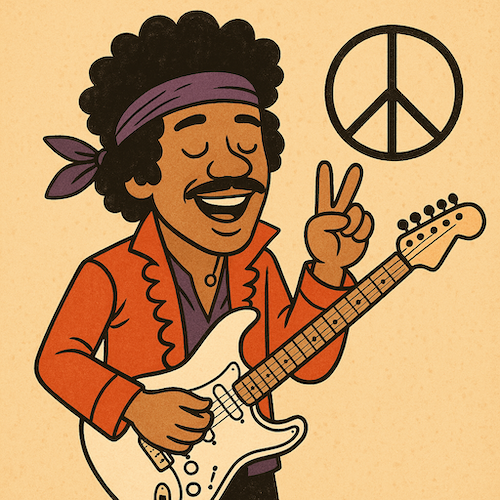Disclaimer: This post may contain affiliate links that allow me to earn a small commission at no extra cost to you
Few figures in music history loom as large as Jimi Hendrix. In a career that barely spanned four years, Hendrix reinvented the electric guitar, shattered musical boundaries, and became a countercultural icon whose influence still echoes across genres and generations. He wasn’t just a guitarist. He was a force of nature with a Fender Stratocaster.
From Seattle to Stardom
Born Johnny Allen Hendrix on November 27, 1942, in Seattle, Washington, Hendrix grew up in a modest home marked by poverty and personal struggles. After a stint in the Army as a paratrooper, he began cutting his teeth as a sideman, backing acts like Little Richard, the Isley Brothers, and Curtis Knight. But it was a trip to London in 1966 that transformed Hendrix from a talented but obscure guitarist into a global sensation.
With the help of Chas Chandler, former bassist of The Animals, Hendrix formed The Jimi Hendrix Experience with Noel Redding and Mitch Mitchell. British audiences were floored. Guitarists like Eric Clapton and Jeff Beck reportedly stood slack-jawed as Hendrix played his guitar behind his head, with his teeth, or engulfed in flames.
Sonic Alchemy
Hendrix wasn’t just flash and spectacle—though he had plenty. He was a sonic architect. His use of distortion, wah-wah, fuzz, and feedback wasn’t just for texture; it was emotional language. Albums like Are You Experienced 1967 (Amazon Link), Axis: Bold as Love 1967 (Amazon Link), and Electric Ladyland 1968 (Amazon Link) weren’t just great rock records. They were statements. Each track was a blend of blues, psychedelia, jazz, funk, and sheer electricity.
Songs like “Purple Haze,” “Voodoo Child (Slight Return),” and “Little Wing” remain masterclasses in tone and expression. And no one will forget his feedback-drenched performance of “The Star-Spangled Banner” at Woodstock in 1969—a searing protest turned national eulogy.
The Myth and the Man
Hendrix was famously soft-spoken and introspective offstage, often at odds with the rock god image the world projected onto him. He struggled with the pressures of fame, management conflicts, and substance use. Tragically, Hendrix died on September 18, 1970, in London, at just 27 years old—joining the infamous “27 Club” alongside Janis Joplin, Jim Morrison, and later Kurt Cobain and Amy Winehouse.
Legacy in Overdrive
What Hendrix left behind is immeasurable. His approach to the guitar changed the instrument forever. His influence runs through Stevie Ray Vaughan’s ferocity, Prince’s versatility, John Mayer’s sensitivity, and even modern guitarists like Gary Clark Jr. and Tosin Abasi.
He made it okay—no, necessary—for guitarists to think differently. To experiment. To make the guitar scream, whisper, cry, and talk back.
And through it all, Jimi Hendrix never stopped being a student of music. “Knowledge speaks,” he once said, “but wisdom listens.” The wisdom in his playing still listens back.
To add an image to your website, use the HTML tag with the src attribute specifying the image URL or path. Here is an example:
Replace “path-to-your-image.jpg” with your image file location and provide an appropriate alt text for accessibility.
